Island Peak, known as Imja Tse, offers a unique blend of adventure and culture in the Everest region of Nepal. Standing at 6,189 meters, it serves as an accessible challenge for novice climbers, featuring a well-structured 14-day itinerary that includes ample acclimatization. Participants not only tackle the climb but also engage with the vibrant Sherpa culture and witness stunning Himalayan vistas. With a mix of trekking and technical climbing, the experience poses essential questions about preparation and expectations that climbers must consider before embarking on this unforgettable journey.
Key Points

- Island Peak, also known as Imja Tse, stands at 6,189 meters and is accessible for beginner climbers with proper acclimatization.
- The typical 14-day expedition includes trekking through scenic routes and cultural exploration in the Everest region.
- Key acclimatization stops at Namche Bazaar and Dingboche enhance climbers’ chances of a successful summit on Day 9.
- Stunning panoramic views of the Himalayan ranges, including Everest, reward climbers at the summit of Island Peak.
- A well-structured itinerary ensures safety and adventure, with local guides and porters supporting the climbing experience.
Overview of Island Peak
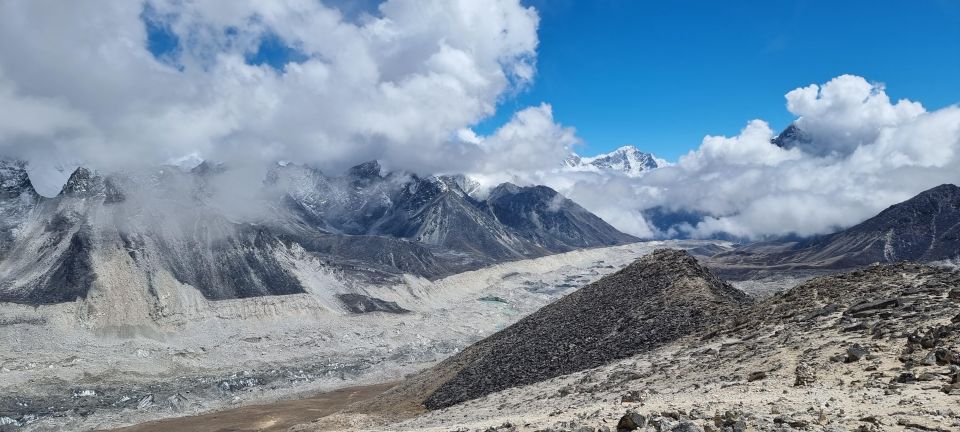
Island Peak, standing at 6,189 meters, is renowned for its accessibility, making it an ideal choice for climbers eager to experience the majestic beauty of the Khumbu region and the thrilling challenge of high-altitude climbing.
Nestled between the Lhotse and Imja glaciers, this impressive peak features a glaciated west face that rises dramatically from the Lhotse Glacier. It’s particularly suitable for beginners, provided they acclimatize properly.
The typical expedition lasts around 14 days, offering ample time for trekkers to explore the stunning landscapes and vibrant Sherpa culture along the way.
Climbers not only get to conquer a peak but also enjoy breathtaking views of the surrounding Himalayan giants, including Lhotse and Ama Dablam, making this adventure unforgettable.
You can also read our reviews of more tours and experiences in Kathmandu.
Detailed Itinerary
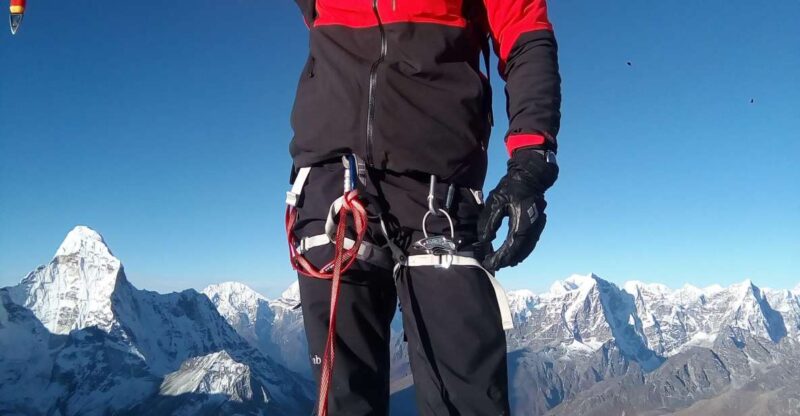
Climbers can expect a well-structured 14-day itinerary that balances trekking, acclimatization, and the exhilarating climb to Imja Tse, ensuring a rewarding experience in the stunning Khumbu region.
This itinerary features:
-
Trekking Stages: Starting from Kathmandu, trekkers make their way through picturesque villages, passing iconic sights like Namche Bazaar and Tengboche.
-
Acclimatization Days: Dedicated days in Namche and Dingboche allow climbers to adjust to altitude, maximizing their chances of a successful summit.
-
Summit Day: Climbers tackle Island Peak on Day 9, with a contingency day built in to address any weather-related challenges.
This thoughtful arrangement guarantees both adventure and safety, making for an unforgettable journey in the Himalayas.
Scenic Highlights
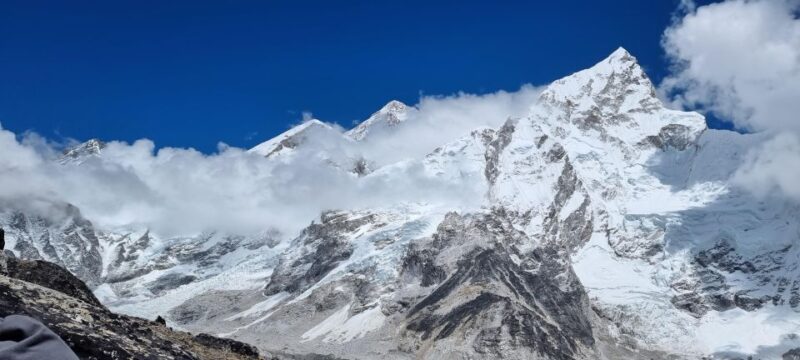
As trekkers ascend through the Khumbu region, they’re treated to breathtaking views of the towering peaks, vibrant Sherpa culture, and serene Buddhist monasteries that define this stunning landscape.
The scenic mountain flight from Kathmandu to Lukla sets the tone, with panoramic vistas that captivate adventurers.
Upon reaching Namche Bazaar, trekkers experience the bustling heart of Sherpa life, surrounded by magnificent mountains like Ama Dablam and Lhotse.
En route to Island Peak, the trek showcases striking views of the glacier-laden terrain and majestic Himalayan ranges.
Upon summiting Island Peak, climbers are rewarded with an awe-inspiring 360-degree panorama that includes Everest, creating an unforgettable backdrop that embodies the spirit of this remarkable journey.
Cultural Experiences

Trekkers enjoy the rich Sherpa culture, exploring vibrant villages, ancient monasteries, and the warm hospitality of the local communities throughout the journey. They witness unique customs and traditions that have been preserved for generations.
Key cultural experiences include:
-
Visiting Monasteries: Trekking through the Khumbu region, they stop at iconic monasteries like Tengboche, where they observe prayer ceremonies and stunning architecture.
-
Interacting with Locals: Engaging with Sherpa families, trekkers learn about their daily lives, customs, and the significance of their mountain heritage.
-
Sampling Local Cuisine: Enjoying traditional Sherpa dishes, such as dal bhat and momo, gives trekkers a taste of the region’s culinary delights.
These experiences enhance their journey, making it not just a climb, but a cultural exploration.
More Great Tours NearbyCost Inclusions
The cost inclusions for the Imja Tse Peak climbing adventure provide essential support, ensuring a well-organized and enjoyable experience from start to finish.
Participants benefit from airport transfers via private car, a comfortable hotel stay in Kathmandu, and a guided city tour.
During the trek, meals and accommodations in guesthouses and tents are covered, along with the expertise of local licensed and climbing guides.
Porter service is included for luggage weighing up to 25 kg, and necessary permits for Everest National Park and Island Peak are arranged.
General climbing equipment, round-trip airfare from Kathmandu to Lukla, and applicable government taxes round out the package, making the journey as seamless as possible for climbers.
Cost Exclusions
While the package covers many essentials, climbers should be aware that certain costs, such as lunch and dinner in Kathmandu, aren’t included in the overall price. Understanding these exclusions can help climbers budget more effectively for their adventure.
Here’s a quick rundown of the main costs that climbers will need to cover on their own:
-
Meals in Kathmandu: Lunch and dinner before and after the trek.
-
Travel Insurance: Essential for covering emergencies or unforeseen circumstances.
-
Personal Expenses: This includes hot drinks, laundry, and tips for guides and porters.
Booking Process
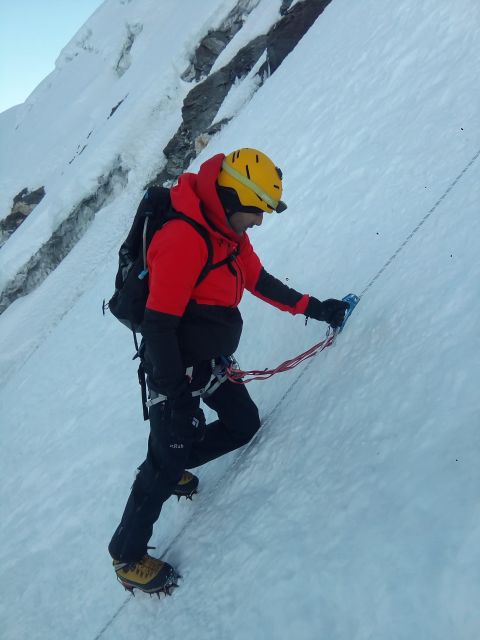
Navigating the booking process for Island Peak climbing can be straightforward and convenient, ensuring adventurers secure their spot for this unforgettable journey.
Prospective climbers can begin by checking availability and selecting desired dates online. With prices starting from $2,322.83 per person, they should review all included services and exclusions carefully.
The booking platform offers a reserve now, pay later option, providing flexibility. Adventurers can also enjoy the peace of mind that comes with free cancellation up to 24 hours in advance for a full refund.
Once booked, climbers will receive details regarding their local English-speaking guide and essential equipment, streamlining the preparation for this exciting trek to Island Peak’s summit.
Preparation Tips
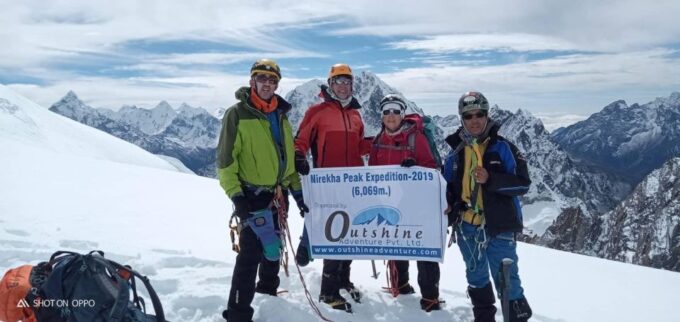
Preparing for the climb to Island Peak requires careful planning and physical conditioning to ensure a safe and enjoyable experience. Climbers should focus on three key preparation tips:
-
Physical Training: Engage in regular cardiovascular workouts, strength training, and hiking to build stamina and muscle endurance. Aim for at least 3-4 months of training prior to the climb.
-
Gear Familiarization: Invest in quality trekking and climbing gear. Practice using equipment like crampons and ice axes in a controlled environment to build confidence.
-
Acclimatization Strategy: Allow time for acclimatization during the trek. Ascend gradually to minimize altitude sickness risks, and listen to your body’s signals throughout the journey.
Frequently Asked Questions
What Is the Best Time to Climb Island Peak?
The best time to climb Island Peak is typically from late spring, around April to May, and early autumn, from September to October. These months offer favorable weather conditions and clearer skies for stunning views.
What Fitness Level Is Required for This Climb?
For this climb, a moderate fitness level’s required. Regular aerobic training, strength exercises, and hiking preparation help build endurance. Proper acclimatization and commitment ensure climbers tackle the challenging terrain effectively and safely.
How Many Climbers Are Typically in a Group?
Typically, groups consist of 6 to 12 climbers, allowing for a balanced experience. This size fosters camaraderie, ensuring everyone receives adequate attention from guides while navigating challenging terrains and enjoying shared achievements along the journey.
Is Prior Climbing Experience Necessary for Island Peak?
Prior climbing experience isn’t necessary for most participants. With proper acclimatization, beginners can successfully summit, thanks to experienced guides and accessible routes. They’ll gain valuable skills and enjoy a rewarding adventure in stunning landscapes.
What Kind of Weather Can We Expect During the Climb?
During the climb, climbers can expect variable weather, including cold temperatures, potential snow, and strong winds. It’s vital they check forecasts regularly and prepare for sudden changes, ensuring they stay equipped for all conditions.
Recap
Climbing Island Peak offers an unforgettable adventure blending breathtaking scenery and rich cultural experiences.
With its well-structured itinerary and acclimatization days, climbers of all levels can safely reach the summit while soaking in the beauty of the Himalayas.
Whether you’re drawn by the challenge or the stunning views, this expedition promises a rewarding experience.
Prepare well, embrace the journey, and get ready to make memories that’ll last a lifetime in the heart of Nepal’s majestic mountains.
You can check availability for your dates here:More Tour Reviews in Kathmandu
Not for you? Here's more nearby things to do in Kathmandu we have reviewed
- From Lukla: Everest Base Camp (EBC) 10-Day Trek
- Kathmandu : Everest Mountain Flight – with Private Transfers
- Full Day : Kathmandu Sightseeing By Bus Day Trip
- Kathmandu: 7 UNESCO World Heritage Sites Day Tour
- Kathmandu: 8-Day Langtang Valley Trek with Transfers
- Thamel Rickshaw Tour
- Everest View Motorbike Tour- 6 Days
- Kathmandu: Top 4 UNESCO Sites Private/Group Tour with Lunch
- From Oceans to Mountains-9 Days (Nepal Guided Tour)
- From Kathmandu: Everest Base Camp Helicopter Tour landings
- Kathmandu: Food and Drink Walking Tour
- Life and spirituality tour of Kathmandu
